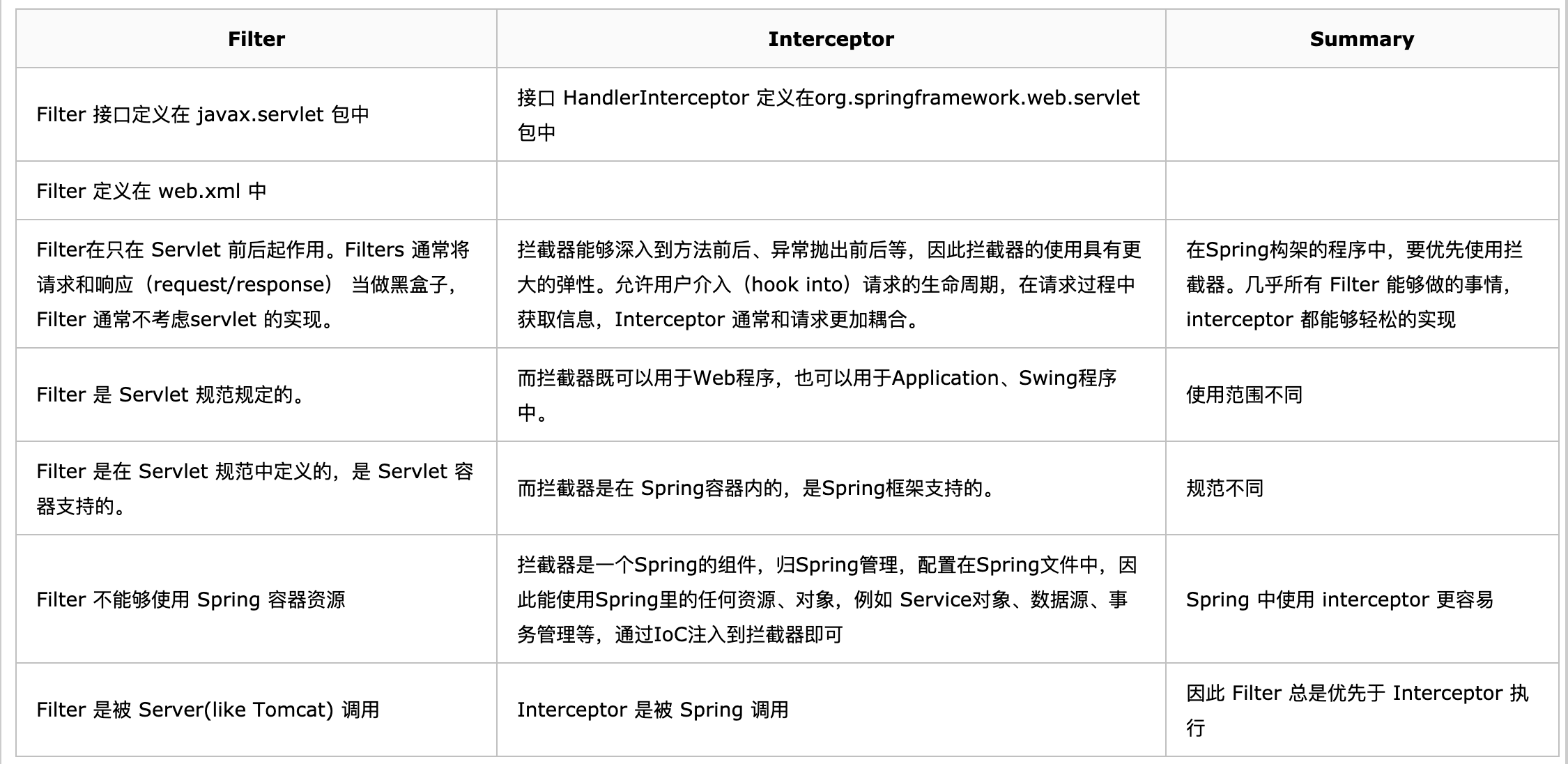过滤器和拦截器
目录
过滤器 filter
springboot使用filter
1、实现Filter接口
@WebFilter(urlPatterns = "/*")//匹配的url路径
public class AppFilter implements Filter {
/**
* 通过WebFilter配置拦截器,可以注入成员
*/
@Autowired
private TestComponent testComponent;
@Override
public void init(FilterConfig filterConfig) throws ServletException {
System.out.println("拦截器init");
}
/**
* 拦截请求
*
* @param servletRequest
* @param servletResponse
* @param filterChain
* @throws IOException
* @throws ServletException
*/
@Override
public void doFilter(ServletRequest servletRequest, ServletResponse servletResponse, FilterChain filterChain) throws IOException, ServletException {
String method = testComponent.method();
System.out.println("过滤器");
filterChain.doFilter(servletRequest, servletResponse);
}
/**
* 程序终止的时候调用
*/
@Override
public void destroy() {
System.out.println("拦截器destroy");
}
}
2、在主类上开启servlet组件的扫描(包括servlet,filter,listener)
@SpringBootApplication
@ServletComponentScan(basePackages = {"com.interceptortest.demo.filter"})//开启扫描filter
public class DemoApplication {
public static void main(String[] args) {
SpringApplication.run(DemoApplication.class, args);
}
}
拦截器 Intercepter
springboot中使用Intercepter
url路径的方式
1、继承HandlerInterceptorAdapter类,实现preHandle方法
@Component
public class AppIntercepter extends HandlerInterceptorAdapter {
@Autowired
private TestComponent testComponent;
@Override
public boolean preHandle(HttpServletRequest request, HttpServletResponse response, Object handler) throws Exception {
System.out.println("拦截器生效\t通过路径拦截");
return true;
}
}
2、实现WebMvcConfigurer接口,重写addInterceptors方法
@Configuration
public class IntercepterConfig implements WebMvcConfigurer {
@Autowired
private AppIntercepter appIntercepter;
@Override
public void addInterceptors(InterceptorRegistry registry) {
//采用注入的方式配置,则Intercepter中可以自动注入成员变量
registry.addInterceptor(appIntercepter).addPathPatterns("/app/**");
//如果是采用new的方式注入,则Intercepter中不能自动注入成员变量,需要手动获取
registry.addInterceptor(new TestIntercepter()).addPathPatterns("/test/**");
}
}
使用注解方式
其实使用注解的方式,原理是将拦截器的作用的url设置为"/*",然后通过判断方法上是否有注解来进行处理
public class TestIntercepter extends HandlerInterceptorAdapter {
@Autowired
private TestComponent testComponent;
@Override
public boolean preHandle(HttpServletRequest request, HttpServletResponse response, Object handler) throws Exception {
//registry.addInterceptor(new TestIntercepter()).addPathPatterns("/test/**");
//如果是采用new的方式注入,则Autowired的字段不会生效,需要重新在上下文中获取
if (testComponent == null) {
WebApplicationContext requiredWebApplicationContext = WebApplicationContextUtils.getRequiredWebApplicationContext(request.getServletContext());
testComponent = (TestComponent) requiredWebApplicationContext.getBean("testComponent");
}
HandlerMethod method = (HandlerMethod) handler;
Anno loginRequired = method.getMethodAnnotation(Anno.class);
if (Objects.isNull(loginRequired)) {
System.out.println("无需拦截");
return true;
} else {
System.out.println("通过注解拦截");
return false;
}
}
}
注意
registry.addInterceptor方法中,最好不要new一个拦截器,因为这样通过spring注入的成员会丢失。
解决方法
通过上下文重新获取
if (testComponent == null) {
WebApplicationContext requiredWebApplicationContext = WebApplicationContextUtils.getRequiredWebApplicationContext(request.getServletContext());
testComponent = (TestComponent) requiredWebApplicationContext.getBean("testComponent");
}
拦截器Intercepter和过滤器filter区别
1、filter在intercepter之前执行
2、intercepter可以通过handler获取更多的信息,包括方法名等(但是获取不到方法参数),但filter只有http相关信息




